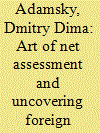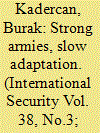| Srl | Item |
| 1 |
ID:
173419


|
|
|
|
|
| Summary/Abstract |
Andrew W. Marshall, who shaped the way in which contemporary international security experts think about strategy, has been mostly associated with the invention of net assessment. The intellectual sources of this analytical technique, and of the related competitive strategies concept, could be traced to Marshall’s efforts to uncover Soviet post-World War II defense transformations. This article outlines the essence of these Soviet innovations – the empirical frame of reference that inspired Marshall. It provides a new perspective on the history of the net-assessment methodology, advances the debate within strategic studies over the nature of military innovations, and offers insights for experts examining defense transformations worldwide.
|
|
|
|
|
|
|
|
|
|
|
|
|
|
|
|
| 2 |
ID:
173814


|
|
|
|
|
| Summary/Abstract |
This article explores the extent to which Moscow’s modus operandi during the military campaign in Syria demonstrates change or continuity in Russian strategic culture. It discusses five main characteristics of the Russian conduct and argues that these traits demonstrate more continuity than change in the Russian style of war. However, it suggests that change possibly might be evolving on the tactical-operational level – the emergence of a mission command culture. The article offers competing explanations for this eventuality, which the Syrian campaign has highlighted, and advances a conceptual debate in IR on the shifts in strategic culture.
|
|
|
|
|
|
|
|
|
|
|
|
|
|
|
|
| 3 |
ID:
134006


|
|
|
|
|
| Publication |
2014.
|
| Summary/Abstract |
What explains the adoption of military innovations? In this article, we assess the empirical validity of adoption capacity theory by reconsidering one methodologically important case analyzed by Michael Horowitz: the diffusion of suicide terrorism. We show that, when addressing problems in Horowitz's research design, the case of suicide terrorism fails to support adoption capacity theory. We argue that, in order to account for the diffusion of this innovation, one needs to take into consideration the tactical incentives to overcome technologically superior enemies. The results of our quantitative and qualitative analyses suggest that terrorist groups fighting against very powerful states in terms of conventional capabilities are more likely to employ suicide attacks than those fighting against poorly equipped ones. Our findings are important because they provide systematic evidence in support of Kalyvas and Sànchez-Cuenca's argument that suicide terrorism is driven by tactical considerations and because they provide confidence in the external validity of Berman and Laitin's hardness of targets hypothesis. Our results also question Lyall and Wilson's finding that highly mechanized armies are inherently inadequate to win counterinsurgency operations. The superior conventional capabilities of a counterinsurgency army might in fact make traditional insurgent tactics ineffective and thus give insurgents an incentive to adopt suicide attacks.
|
|
|
|
|
|
|
|
|
|
|
|
|
|
|
|
| 4 |
ID:
127891


|
|
|
|
|
| Publication |
2013.
|
| Summary/Abstract |
Why are some states more willing to adopt military innovations than others? Why, for example, were the great powers of Europe able to successfully reform their military practices to better adapt to and participate in the so-called military revolution of the sixteenth and seventeenth centuries while their most important extra-European competitor, the Ottoman Empire, failed to do so? This puzzle is best explained by two factors: civil-military relations and historical timing. In the Ottoman Empire, the emergence of an institutionally strong and internally cohesive army during the early stages of state formation-in the late fourteenth century-equipped the military with substantial bargaining powers. In contrast, the great powers of Europe drew heavily on private providers of military power during the military revolution and developed similar armies only by the second half of the seventeenth century, limiting the bargaining leverage of European militaries over their rulers. In essence, the Ottoman standing army was able to block reform efforts that it believed challenged its parochial interests. Absent a similar institutional challenge, European rulers initiated military reforms and motivated officers and military entrepreneurs to participate in the ongoing military revolution.
|
|
|
|
|
|
|
|
|
|
|
|
|
|
|
|